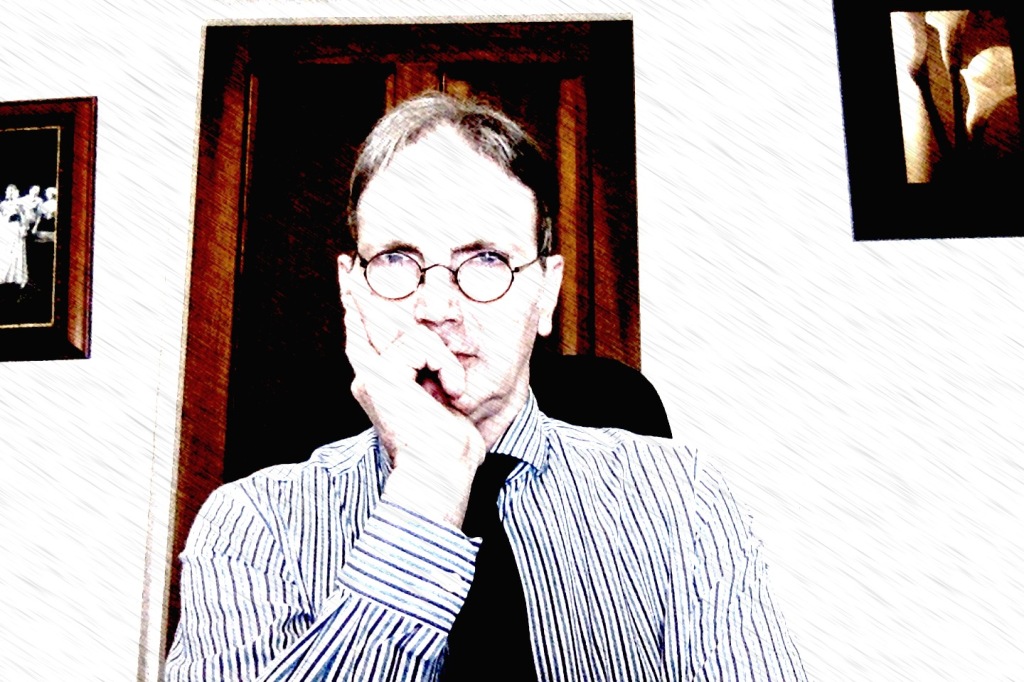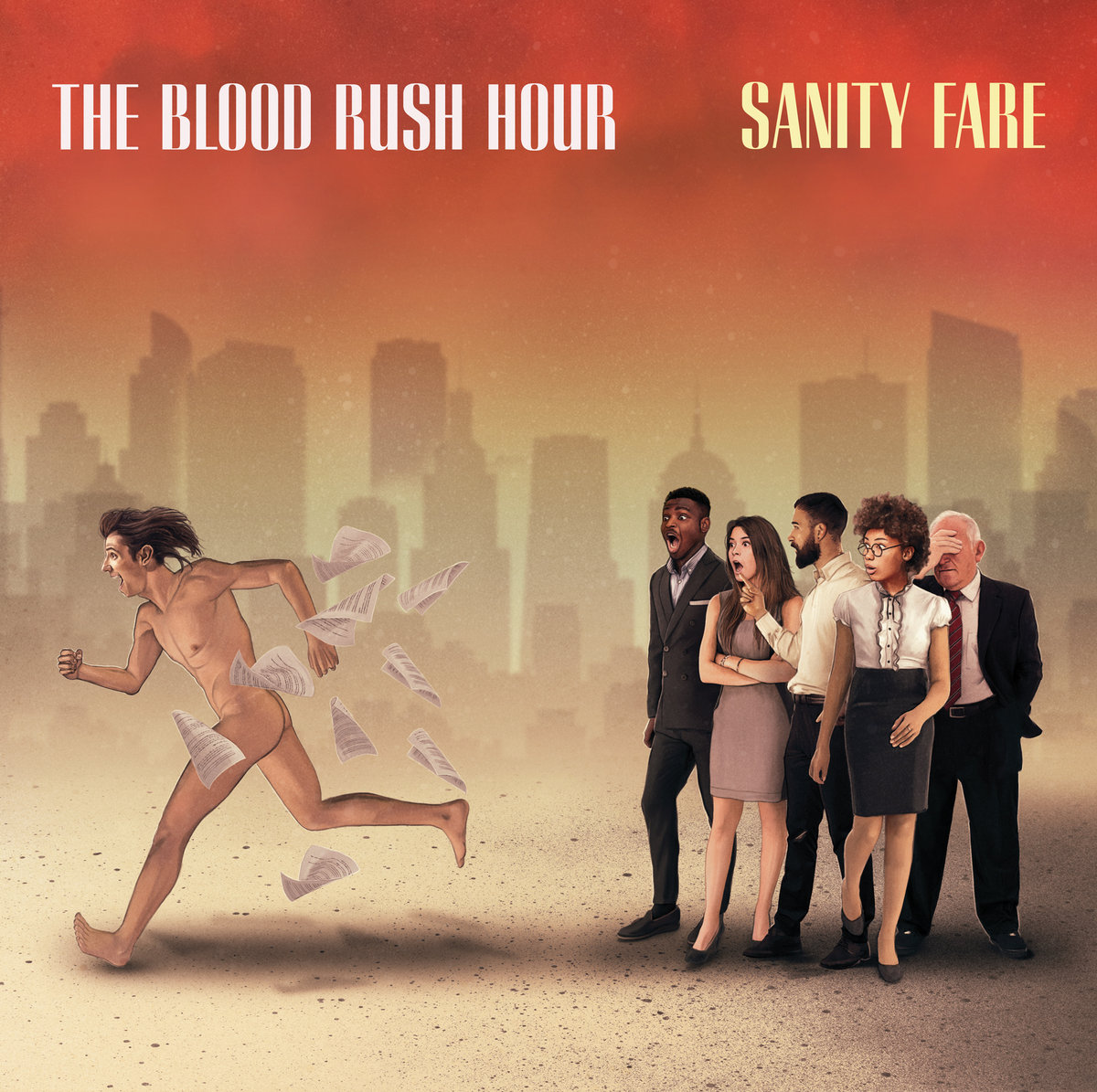
With a band name lifted from a Bonzo Dog Band lyric, a heavily multi-tracked studio sound and complex pop songs that turn on a dime, The Blood Rush Hour are a band very much rooted in the progressive pop movement of the early 1970s. Almost six years in the making, their fourth and latest album is filled to the brim with dizzyingly busy yet catchy pop. Michael Björn talks to bandleader Robert DeStefano to find out more.
“Sanity Fare is one work, like a symphony or something,” explains DeStefano. “There are songs that do certain things in the progression of the album, taking you on a journey.” In fact, there is more of a night at the opera here than even a Queen album, structured as it is in two intense halves with the first half winding down to the short stillness of ‘Lost Girl’ followed by an instrumental track acting as intermission music. “‘Lost Girl´ is something completely different,” agrees DeStefano. “And then the ‘Intermezzo’, is almost like elevator music. It is there to just give a little bit of a palate cleanser.”
It may seem strange to make an album that requires a cleanser break in the middle, but music by The Blood Rush Hour is not made for easy listening. “Music has always been so special to me, so enveloping. I write from that perspective, and I suppose maybe for people who feel that way as well,” explains DeStefano. “My songs don’t have soundbites. I don’t repeat the same four chords.”
This also goes for the lyrics, that are plentiful and often have no discernible choruses to use as pegs for orientation. “I remember reading a review once of [second album] And Then… The Unthinkable Happened saying: ‘This is the only album I’ve ever listened to that I had to bring a dictionary’,” comments DeStefano. The new album also gives opportunity to test your literacy, with lyrics asking questions like: When did our dear wood become fenny? “I don’t like dumbing my lyric down,” says DeStefano. “Song lyrics should stand on their own as poems. So I work hard on that, the music actually comes much easier to me.”
And that music is typically quite richly produced. “A couple of songs on there had over a hundred tracks because of the way that I record backing vocals,” says DeStefano by way of example. “I like to record triple passes of the vocals in the middle, and do maybe a double pass of the high and a single pass of the low. Those things add up.” This layered method is used for instruments as well, resulting in a quite orchestrated studio pop sound. “I use the studio as an instrument. I’ll just start playing how I feel, thinking of melodies going in my head, trying to duplicate it on the piano. And eventually I come up with what I need. So it’s a very expensive way of working.”
Musically, inspiration is drawn from many genres. Beyond rock and pop, there are classical influences, Bossa Nova and salsa. Jazz vocalisations and chords structures are all over the place. “All these styles are kind of integrated into a single expression. I remember buying the Beatles’ White Album and just thinking how every track was so different than the one before it. Even at nine years old, it was just mind blowing to me.” But DeStefano also draws the line somewhere. “I don’t do a lot of folk ballads, where you’re telling a story.”

Although Robert DeStefano lives in Swansea in Wales, and all of the Blood Rush Hour albums have been written there, he is originally from New Jersey in the USA. He had a band called the Shades together with his brother and his teenage friends, and they released the single Hello, Mr. Johnson in 1980. “I was 17 and was the songwriter and lead singer,” says DeStefano. “We gained a bit of notoriety in the area: Philadelphia, New York City, Washington, DC.” Although very much a power pop track, listening back an interest in something a bit more advanced is also already discernible. But there would be no follow-up single and the band broke up. “I had some issues with substances,” explains DeStefano. “When I finally addressed those issues, I was in my mid 20s. I feared going back into music, and put it behind me.”
However, on a holiday trip to visit family back in the States in 2010, his brother Jack was invited for an interview to a radio station doing a retrospective about local bands, and DeStefano went along with him. They talked a little bit about the old days, but when the radio host asked if they would like to do a reunion concert, brother Jack said yes before DeStefano had time to react. “I’m always listening to what everyone is playing so playing live is a bit stressful,” says DeStefano. “But it was such a wonderful experience to get these guys back together. It reawakened my love for music.”
Back home in Wales again, DeStefano had come up with some song ideas. When asking at the local record shop where he might be able to record, he was pointed to Sonic One, a studio run by Tim Hamill. “Tim and I just hit it off very, very well,” remembers DeStefano.
The initial sessions with Tim started what eventually became the debut album Shrink. His old mates from the States flew over to Wales for the sessions, abetted with some of Tim’s friends like Christian Phillips from Sonic Executive Sessions. “Once I had enough down to release an album, I kind of liked the idea of having a band name,” says DeStefano. When he was a kid, a friend’s older brother had a lot of import albums from the UK, including Keynsham by the Bonzo Dog Band. “I fell in love with the Bonzos at that point, which is probably not a very good thing for a young developing mind,” says DeStefano with a laugh. “One of my favourite Bonzo tracks is a song called ‘Busted’, which has the lines: ‘All together in the Blood Rush Hour! / C’mon fish-face, you got the power!’” With the band name settled, the album title Shrink was inspired by DeStefano’s profession. “I’m a psychotherapist,” he explains. “My sessions are an hour and they’re often very intense. So it kind of fit in that way. “
Subsequent albums have been recorded in similar fashion, although increasingly an American studio has been utilised to reduce some of the intercontinental travel. However, all of it was always put together in Tim Hamill’s studio. That is also how the new album started, until there was an opportunity to have Willie Dowling (most recently of Dowling Poole fame) produce some of it.

Although it was a bit delicate to switch producer midway through, DeStefano couldn’t turn down the opportunity. “I went to Willie’s studio in France for one week on three different occasions. All the songs had been written at Tim’s and we had already started overdubbing them before I sent them to Willie.” Working with Willie had an impact on the sound, as Willie’s own music often has a tendency to be saturated with sound in a similar fashion as the music of The Blood Rush Hour. He added guitars and also played bass on several tracks. ”I like to have the arrangement done prior to hearing what the bass needs to do,” explains DeStefano. “Counter melody, counter rhythms, all of that kind of stuff. On ‘Billy Boy’, for instance, you’ll hear the bass playing harmony with the lead vocal on the first verse.”
With similar musical approaches, DeStefano and Willie mostly agreed on the mixes, although ‘Fashion Footsteps’ was the exception that proved the rule. “In the last chorus there’s a part where the backing vocals do a bit of call and answer that Willie took out of the mix,” remembers DeStefano. “So I asked him to please put it back in. And he did.” Although calm and quite beautiful, the song has a very dark theme. “The first verse is about walking along the sands of Southerndown Beach – a beach in Bridgend in Wales at the foot of about a 400 metter tall cliff,” says DeStefano. “It is popular for people to jump from… This album is darker, lyrically and musically, probably because of the pandemic and the craziness in the world”
Darker maybe, and like the debut, an album with a title inspired by DeStefano’s psychotherapy worklife, with the sanity fare seen as the price you pay for sanity. But on a lighter side, it is also a word play. “In English literature, if you go to the 100 books that everyone should read, Vanity Fair is one of them,” explains DeStefano. That begs the question: Is Sanity Fare one of the 100 must hear records for you? If you are willing to spend the effort, it is an album that gradually opens up and reveals itself to the listener. And it’s rewards are certainly plentiful.

